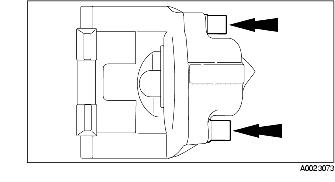CALIPER (FRONT) DISASSEMBLY/ASSEMBLY
id041100801000
Disassembly
1. Remove the caliper from the vehicle. (See CALIPER (FRONT) REMOVAL/INSTALLATION.)
2. Remove the guide pins and the boot.
3. Remove the dust boot.
4. Remove the caliper piston.
-
Warning
-
• Use only as much compressed air as necessary to remove the piston. Excessive pressure can force the piston out of the caliper to cause personal injury. Never attempt to catch the piston by hand as it comes out of the caliper. Failure to follow these instructions may result in personal injury.
-
Caution
-
• Do not use a screwdriver or any other similar tool to pry the piston out of the bore. Piston damage could result.
-
Note
-
• Inspect the piston for wear, rust, or pits. If any of these conditions exist, a new piston must be installed.
-
(1) Position a block of wood between the piston and the caliper.
-
(2) Apply compressed air to the caliper to remove the piston.
5. Remove the bleeder cap and bleeder screw.
6. Remove the piston seal.
-
Caution
-
• Use a plastic or wooden pick to remove the piston seal from the caliper. A metal tool may scratch or nick the seal groove, which could result in a fluid leakage.
-
Note
-
• Inspect the caliper for wear, rust, or pits. If any of these conditions exist, do not hone; a new caliper must be installed.
Assembly
1. Assemble in the reverse order of disassemble.
-
Caution
-
• Do not use denatured alcohol to clean rubber components or assemblies that have rubber components. Cleaning rubber components with denatured alcohol weakens the rubber and may result in failure of the component.
-
• Never allow any petroleum product or mineral oil to contact the inside of a brake system. Mineral oil and petroleum products deteriorate the natural rubber seals used in brake system. If a brake system becomes contaminated, it must be flushed with clean brake fluid and all rubber seals and hoses replaced. Use specified brake fluid.
-
Note
-
• Verify that the seal is not twisted and is firmly seated in the caliper groove.
-
• Clean all caliper components. All parts must be air-dried completely. Coat all internal parts and the piston seal with specified brake fluid before installation.
